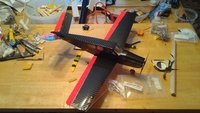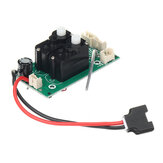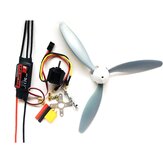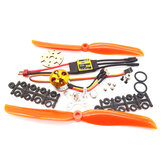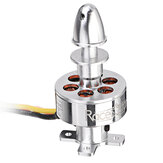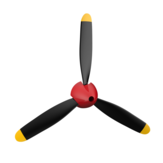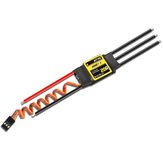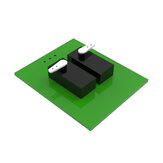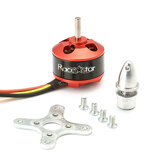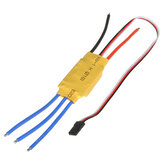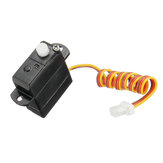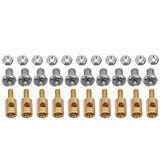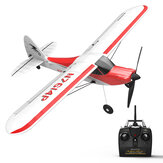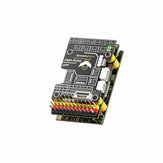Ensemble combo de moteur CW sans noyau 0720 + hélice pour avions de modèles RC DIY Parkfly
Avis des clients
- Tous les Commentaires (670)
- Image (71)
- Vidéo (3)
Une partie de la critique a été traduite automatiquement.
-
29/09/2015
I took a chance on this, because I didn't think there was enough information in the description. I ordered the C version, with the 8x20mm motor, but unfortunately what arrived today was the A version, with 7x16mm motor, so the figures below are for the A version. I haven't powered it up yet, but I think it will be very suitable for an indoor slow flyer of the Vapor, Ember, Cub etc. style. With the 8x20mm motor probably something a bit bigger and/or faster. The prop has a diameter of 138mm, but no pitch marked. By comparing it with other props of known pitch I am guessing it is a 138x63 mm or 5425 inches. It came badly out of balance, but by taking tiny shavings off the heavy blade with a modelling knife, I eventually got it to balance perfectly. It is very light at 1.24g, and I don't think it would withstand a hard impact, but ideal for a slow flyer. The description says it has a .8mm hole, but when I measured the prop shaft, it is 1mm diameter. I tried pushing it into the prop and it is a very tight fit, but does go in. The gearbox is the usual two brass bush type, with plastic 9 tooth pinion and gear. I didn't count the teeth on the gear, but I'm guessing there are 54 giving a 6:1 ratio. The prop shaft is 27mm long with one end knurled for a length of about 8mm. I think the knurled end goes into the plastic nut provided, with the smooth end going into the prop, so you can remove and replace a prop without much trouble. Weight of the gearbox is 1.29g and of the motor 2.61g. Motor shaft is 1mm diameter. There is a square hole in the gearbox that I think is intended for mounting on the end of a square section carbon fibre rod, such as you might use for the fuselage of a very light slow flyer of the Vapor type. It looks as though it is a 2x2mm hole. It would probably be possible to mount the motor/gearbox other ways, e.g. with tiny cable ties or with glue. The proof will be in how it runs, but at this stage I think it's a very light and economical power plant for an indoor flyer, with flexibility in the choice of motor according to your intended use.
Commentaires (5)Afficher l'original -
 NeslarcVIP2US07/08/2019
NeslarcVIP2US07/08/2019Great micro motor for ultra light aircraft under 4 ounces. It ships unassembled but assembly is easy. The propeller balance should be checked and corrected before use. The gear is a little noisy at low rpm but it smooths out at flying speed. I used one in a Guillow's Lancer airplane I converted from rubber power to electric motor and 3 channel RC. This motor and propeller provide more than enough thrust for this under 50 gram airplane.
Commentaires (3)Afficher l'original -
26/09/2018
Nice Motor....... Enough Thrust power to my DIY plane.....
Commentaires (1)Afficher l'original -
 gozVIP3CA03/12/2020
gozVIP3CA03/12/2020beau petit moteur vous devez cependant ajuster le trim des gaz pour avoir une impulsion de départ sinon le moteur ne tourne pas , je l ai mis sur un beechcraft mini de chez banggood
Commentaires (1)Afficher l'original -
14/10/2020
Livraison rapide, état parfait, ne peut pas attendre pour obtenir la construction
CommentairesAfficher l'original -
 HenningSVIP4DE12/12/2020
HenningSVIP4DE12/12/2020Kit d'entraînement léger et fin. Pas d'instructions fournies, donc vous devriez regarder l'image bien avant de l'assembler. Les buissons doivent être bien alignés, sinon l'arbre tend à se serrer et à fonctionner avec une friction élevée. Mon kit dessine 80mA à 4.0V (à 1s lipo) et montre quelques vibrations - va équilibrer l'accessoire et voir alors si elle tire assez pour mon flyer intérieur...
CommentairesAfficher l'original -
08/11/2017
this item is very good has super power i use for mini cessna airplain fly very good https://www.youtube.com/watch?v=sOhNC9UEu_U&feature=youtu.be
Commentaires (1)Afficher l'original -
27/03/2020
Il génère une bonne poussée avec un faible courant. Mais l'accessoire était totalement déséquilibré et a généré de fortes vibrations. Tu dois vraiment l'équilibrer. J'avais prévu de l'utiliser sur mon planeur de 35cm, mais il est trop gros et lourd. Le moteur Racerstar 8520 avec l'hélice KingKong 65mm est le meilleur choix - même si le courant est beaucoup plus élevé pour une poussée plus faible.
CommentairesAfficher l'original -
 LOVBOYVIP1IN24/11/2018
LOVBOYVIP1IN24/11/2018nice product but motor shaft is very tigh t and motor casing is very tight too you have to make that bigger to fit
CommentairesAfficher l'original -
 plangerVIP5FR31/08/2017
plangerVIP5FR31/08/2017Works perfectly fine for small indoor models.
CommentairesAfficher l'original






